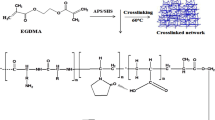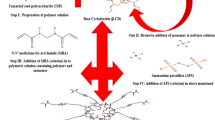Abstract
The major objective of this study is to fabricate a very promising system by loading anticancer agent in it which could be given to the cancer patients by oral administration and additionally that will liberate drugs in large intestine (affected/cancerous area). Minimum or no exposure of chemotherapeutic agents to gastric/small intestine will significantly eliminate the problem of adverse drug reactions. Cancer patients are facing severe problem of side/adverse effects due to intravenous colorectal carcinoma chemotherapy. So, an oral drug delivery system is designed to substitute the intravenous drug therapy. This study reports the synthesis of hybrid polymeric polyethylene glycol hydrogels (PEGA 4000) based on acrylic acid (AA), ammonium peroxodisulfate and ethylene glycol dimethacrylate (EGDMA) by solution polymerization method. PEGA 4000 hydrogels were used for colon targeting of hydrophilic anti-carcinoma drug (oxaliplatin). Development of new structure was confirmed by Fourier transform infrared spectroscopy. Surface morphology of developed hydrogel slabs was examined by scanning electron microscopy. Thermal gravimetric analysis of hydrogels revealed that there was an increase in thermal stability of PEGA 4000 hydrogels. Swelling study was performed in acidic and basic pH medium provided important information on drug release characteristics of hydrogels. The release of oxaliplatin (OXP) was significantly retarded at pH 1.2, while rapid release was observed at pH 7.4. The release rate of OXP increased with increasing concentration of PEG 4000 and AA. However, extent of drug release was significantly reduced on increasing concentration of EGDMA. Mechanism of release has been evaluated by applying various mathematical kinetic models. The tensile mechanical strength and elongation at break were also observed on different formulations based on various ratios of reaction contents. The consequents of our study suggest that fabricated PEGA 4000 hydrogels could serve as suitable target release delivery system and toxicity study endorsed biocompatibility of hydrogels to biological system.
Graphic abstract












Similar content being viewed by others
References
Ray M, Pal K, Anis A, Banthia A (2010) Development and characterization of chitosan-based polymeric hydrogel membranes. Des Monomers Polym 13(3):193–206
Masteikova R, Chalupova Z, Sklubalova Z (2003) Stimuli-sensitive hydrogels in controlled and sustained drug delivery. Medicina 39(2):19–24
Bai XY, Yan Y, Wang L, Zhao LG, Wang K (2015) Novel pH-sensitive hydrogels for 5-aminosalicylic acid colon targeting delivery: in vivo study with ulcerative colitis targeting therapy in mice. Drug Deliv 23(6):1926–1932
Qiu Y, Park K (2001) Environment-sensitive hydrogels for drug delivery. Adv Drug Deliv Rev 53(3):321–339
Qian Y-C, Chen P-C, Zhu X-Y, Huang X-J (2015) Click synthesis of ionic strength-responsive polyphosphazene hydrogel for reversible binding of enzymes. RSC Adv 5(55):44031–44040
Shantha K, Harding D (2002) Synthesis and evaluation of sucrose containing polymeric hydrogels for oral drug delivery. J Appl Polym Sci 84(14):2597–2604
Can V, Abdurrahmanoglu S, Okay O (2007) Unusual swelling behavior of polymer–clay nanocomposite hydrogels. Polymer 48(17):5016–5023
Patel R, Patel M (2008) Preparation, characterization, and dissolution behavior of a solid dispersion of simvastatin with polyethylene glycol 4000 and polyvinylpyrrolidone K30. J Dispersion Sci Technol 29(2):193–204
Shah S, Ranjha NM, Javaid Z (2013) Development and evaluation of pH-dependent interpenetrating network of acrylic acid/polyvinyl alcohol. Iran Polym J 22(11):811–820
Liu Z, Rempel G (1997) Preparation of superabsorbent polymers by crosslinking acrylic acid and acrylamide copolymers. J Appl Polym Sci 64(7):1345–1353
Devine DM, Higginbotham CL (2005) Synthesis and characterisation of chemically crosslinked N-vinyl pyrrolidinone (NVP) based hydrogels. Eur Polym J 41(6):1272–1279
Cheng G, An F, Zou M-J, Sun J, Hao X-H, He Y-X (2004) Time-and pH-dependent colon-specific drug delivery for orally administered diclofenac sodium and 5-aminosalicylic acid. World J Gastroenterol 10(12):1769–1774
Yang L, Chu JS, Fix JA (2002) Colon-specific drug delivery: new approaches and in vitro/in vivo evaluation. Int J Pharm 235(1):1–15
Ramteke KH, Nath L (2012) Formulation, evaluation and optimization of controlled release hydrogel microspheres for colon targeted drug delivery. J Pharm Sci Res 4(2):1739–1747
Omar S, Aldosari B, Refai H, Al Gohary O (2007) Colon-specific drug delivery for mebeverine hydrochloride. J Drug Target 15(10):691–700
Burz C, Berindan-Neagoe I, Balacescu O, Tanaselia C, Ursu M, Gog A, Vlase L, Chintoanu M, Balacescu L, Leucuta SE (2009) Clinical and pharmacokinetics study of oxaliplatin in colon cancer patients. J Gastrointestin Liver Dis 18(1):39–43
Suzuki R, Takizawa T, Kuwata Y, Mutoh M, Ishiguro N, Utoguchi N, Shinohara A, Eriguchi M, Yanagie H, Maruyama K (2008) Effective anti-tumor activity of oxaliplatin encapsulated in transferrin-PEG-liposome. Int J Pharm 346(1):143–150
Vivek R, Thangam R, Nipunbabu V, Ponraj T, Kannan S (2014) Oxaliplatin-chitosan nanoparticles induced intrinsic apoptotic signaling pathway: a “smart” drug delivery system to breast cancer cell therapy. Int J Biol Macromol 65:289–297
Samanta HS, Ray SK (2014) Synthesis, characterization, swelling and drug release behavior of semi-interpenetrating network hydrogels of sodium alginate and polyacrylamide. Carbohyd Polym 99:666–678
Yin Y, Ji X, Dong H, Ying Y, Zheng H (2008) Study of the swelling dynamics with overshooting effect of hydrogels based on sodium alginate-g-acrylic acid. Carbohyd Polym 71(4):682–689
Liu ZL, Hu H, Zhuo RX (2004) Konjac glucomannan-graft-acrylic acid hydrogels containing azo crosslinker for colon-specific delivery. J Polym Sci Part A Polym Chem 42(17):4370–4378
Rashid A, Ahmad M, Tulain UR, Iqbal FM (2015) Fabrication and evaluation of 2-hydroxyethyl methacrylate-co-acrylic acid hydrogels for sustained nicorandil delivery. Trop J Pharm Res 14(7):1121–1128
Kundanati L, Singh SK, Mandal BB, Murthy TG, Gundiah N, Pugno NM (2016) Fabrication and mechanical characterization of hydrogel infused network silk scaffolds. Int J Mol Sci 17(10):1631
Vazquez OR, Avila IO, Juan C, Hernandez E (2016) An overview of mechanical tests for polymeric biomaterial scaffolds used in tissue engineering. J Res Updates Polym Sci 4(4):168–178
Khalid I, Ahmad M, Usman Minhas M, Barkat K, Sohail M (2016) Cross-linked sodium alginate-g-poly (acrylic acid) structure: a potential hydrogel network for controlled delivery of loxoprofen sodium. Adv Polym Technol 37(4):985–995
Erum A, Bashir S, Saghir S (2015) Modified and unmodified arabinoxylans from Plantago ovata husk: novel excipients with antimicrobial potential. Bangladesh J Pharmacol 10(4):765–769
Zhuo RX, Li W (2003) Preparation and characterization of macroporous poly(N-isopropylacrylamide) hydrogels for the controlled release of proteins. J Polym Sci Part A Polym Chem 41(1):152–159
Doshi D, Ravis W, Betageri G (1997) Carbamazepine and polyethylene glycol solid dispersions: preparation, in vitro dissolution, and characterization. Drug Dev Ind Pharm 23(12):1167–1176
Li Y, Ma Q, Huang C, Liu G (2013) Crystallization of poly(ethylene glycol) in poly(methyl methacrylate) networks. Mater Sci 19(2):147–151
Caoa Y, Guana Y, Dua J, Penga Y, Yipb C, Chanbb AS (2003) Polymer network-poly(ethylene glycol) complexes with shape memory effect. Chin J Polym Sci 21(1):29–33
Mandal B, Ray SK (2013) Synthesis of interpenetrating network hydrogel from poly (acrylic acid-co-hydroxyethyl methacrylate) and sodium alginate: modeling and kinetics study for removal of synthetic dyes from water. Carbohyd Polym 98(1):257–269
Das N (2013) Preparation methods and properties of hydrogel: a review. Int J Pharm Pharm Sci 5(3):112–117
Kim B, Peppas NA (2003) Poly (ethylene glycol)-containing hydrogels for oral protein delivery applications. Biomed Microdevice 5(4):333–341
Hussain T, Ranjha NM, Shahzad Y (2011) Swelling and controlled release of tramadol hydrochloride from a pH-sensitive hydrogel. Des Monomers Polym 14(3):233–249
Murthy PK, Mohan YM, Sreeramulu J, Raju KM (2006) Semi-IPNs of starch and poly (acrylamide-co-sodium methacrylate): Preparation, swelling and diffusion characteristics evaluation. React Funct Polym 66(12):1482–1493
Rao KK, Subha M, Sairam M, Halligudi S, Aminabhavi T (2006) Synthesis, characterization and controlled release characteristics of PEGylated hydrogels for diclofenac sodium. Des Monomers Polym 9(3):261–273
Liu C, Desai KGH, Liu C (2005) Enhancement of dissolution rate of valdecoxib using solid dispersions with polyethylene glycol 4000. Drug Dev Ind Pharm 31(1):1–10
Liu C, Desai KGH (2005) Characteristics of rofecoxib-polyethylene glycol 4000 solid dispersions and tablets based on solid dispersions. Pharm Dev Technol 10(4):467–477
Peppas NA, Korsmeyer RW (1987) Dynamically swelling hydrogels in controlled release applications. Hydrog Med Pharm 3:109–136
Korsmeyer R, Gurny R, Doelker E, Buri P, Peppas N (1983) Mechanisms of potassium chloride release from compressed, hydrophilic, polymeric matrices: effect of entrapped air. J Pharm Sci 72(10):1189–1191
Shah SA, Sohail M, Minhas MU, Khan S, Hussain Z, Mahmood A, Kousar M, Mahmood A (2019) pH-responsive CAP-co-poly(methacrylic acid)-based hydrogel as an efficient platform for controlled gastrointestinal delivery: fabrication, characterization, in vitro and in vivo toxicity evaluation. Drug Deliv Trans Res 9:555–577
Johnson B, Beebe D, Crone W (2004) Effects of swelling on the mechanical properties of a pH-sensitive hydrogel for use in microfluidic devices. Mater Sci Eng C 24(4):575–581
Nakayama A, Kakugo A, Gong JP, Osada Y, Takai M, Erata T, Kawano S (2004) High mechanical strength double-network hydrogel with bacterial cellulose. Adv Func Mater 14(11):1124–1128
Zhong M, Liu Y-T, Xie X-M (2015) Self-healable, super tough graphene oxide–poly(acrylic acid) nanocomposite hydrogels facilitated by dual cross-linking effects through dynamic ionic interactions. J Mater Chem B 3(19):4001–4008
Onwusonye J, Muritala I, Odu D, Uzomba N, Ogbonnaya M, Duruamaku C (2016) Oral acute toxicity study of methanol leaf extracts of Croton Zambesicus in mice. Merit J Pharm Pharm Sci 2(1):1–5
Mahmood A, Ahmad M, Sarfraz RM, Minhas MU (2016) β-CD based hydrogel microparticulate system to improve the solubility of acyclovir: optimization through in vitro, in vivo and toxicological evaluation. J Drug Deliv Sci Technol 36:75–88
Rashmi R, Jayakumar K, Swamy MN, Bhat A (2012) Acute oral toxicity study of norfloxacin in female rats. Int J Pharma Bio Sci 3(1):98
Ali R, Ali R, Jaimini A, Nishad DK, Mittal G, Chaurasia OP, Kumar R, Bhatnagar A, Singh SB (2012) Acute and sub acute toxicity and efficacy studies of Hippophae rhamnoides based herbal antioxidant supplement. Indian J Pharmacol 44(4):504
Pariyani R, Safinar Ismail I, Azam AA, Abas F, Shaari K, Sulaiman MR (2015) Phytochemical screening and acute oral toxicity study of java tea leaf extracts. BioMed Res Int. https://doi.org/10.1155/2015/742420
Acknowledgements
Authors are grateful to the Faculty of Pharmacy and Alternative Medicine, the Islamia University of Bahawalpur, Pakistan, which rendered us all conveniences, chemicals and equipment to carry out this study.
Author information
Authors and Affiliations
Corresponding author
Additional information
Publisher's Note
Springer Nature remains neutral with regard to jurisdictional claims in published maps and institutional affiliations.
Rights and permissions
About this article
Cite this article
Barkat, K., Ahmad, M., Minhas, M.U. et al. Understanding mechanical characteristics of pH-responsive PEG 4000-based polymeric network for colorectal carcinoma: its acute oral toxicity study. Polym. Bull. 78, 5075–5101 (2021). https://doi.org/10.1007/s00289-020-03356-4
Received:
Revised:
Accepted:
Published:
Issue Date:
DOI: https://doi.org/10.1007/s00289-020-03356-4




